Macroeconomics CA1 Report: Singapore Economic Analysis (ECO2103)
VerifiedAdded on 2022/11/14
|9
|2576
|291
Report
AI Summary
This macroeconomics report, prepared for the ECO2103 course, analyzes five articles related to the Singaporean economy, covering topics from May 2019 onwards. The report begins with an analysis of GDP and economic growth, examining the impact of the US-China trade war on Singapore's exports. It then delves into inflation and price levels, evaluating the core inflation rate and consumer price index. The report continues with an analysis of wages and unemployment, discussing the effects of full employment on wage increases. The fourth chapter focuses on saving, capital formation, and financial markets, highlighting the need for reforms in Singapore's capital market. Finally, the report analyzes short-term economic fluctuations and aggregate expenditures, discussing the possibility of a recession. The report concludes that Singapore is experiencing below average growth and economic contraction. The student used various analytical tools and macroeconomic concepts to provide the analysis.

Running head: MACROECONOMICS
Macroeconomics
Name of the Student
Name of the University
Course ID
Macroeconomics
Name of the Student
Name of the University
Course ID
Paraphrase This Document
Need a fresh take? Get an instant paraphrase of this document with our AI Paraphraser
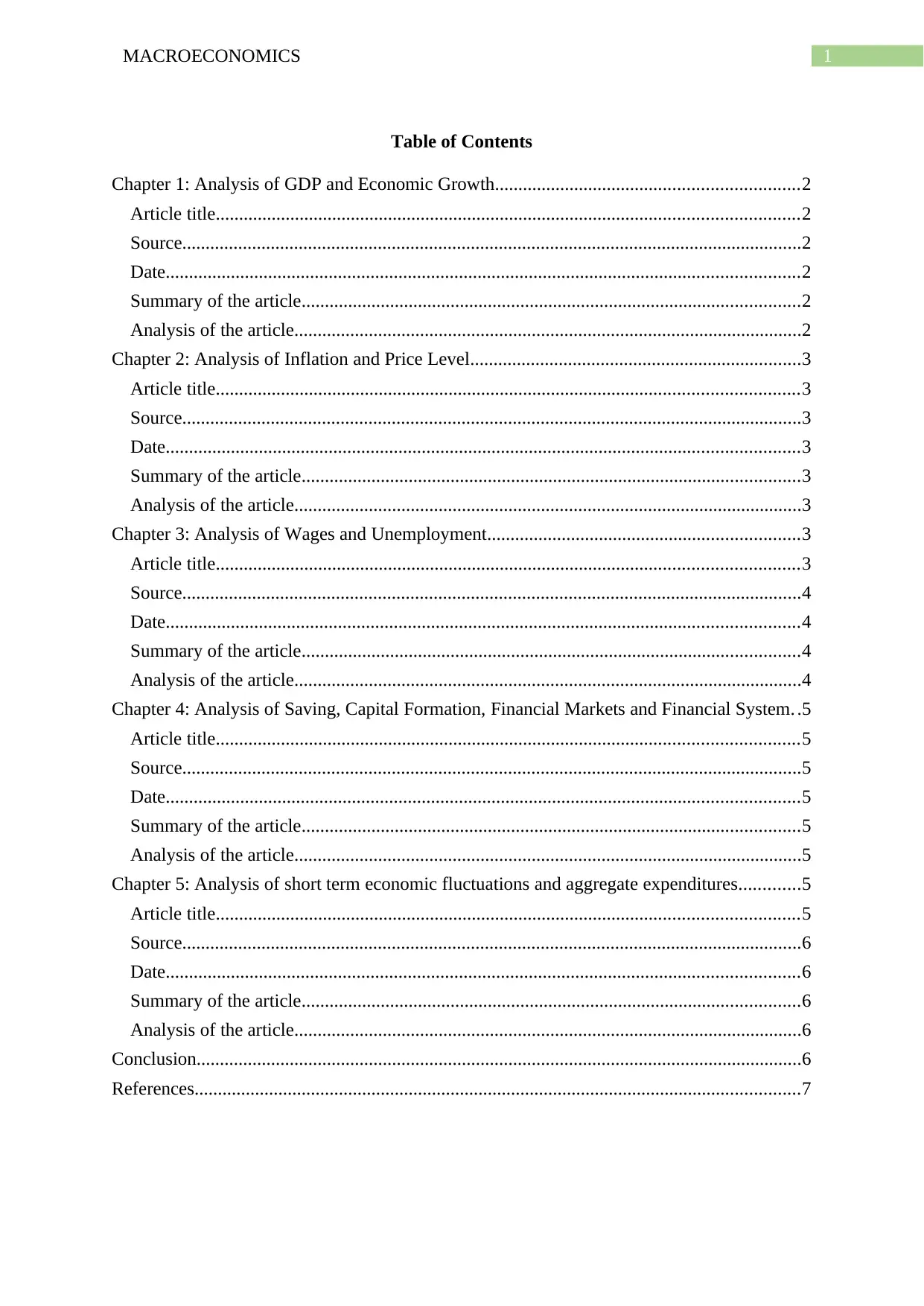
1MACROECONOMICS
Table of Contents
Chapter 1: Analysis of GDP and Economic Growth.................................................................2
Article title.............................................................................................................................2
Source.....................................................................................................................................2
Date........................................................................................................................................2
Summary of the article...........................................................................................................2
Analysis of the article.............................................................................................................2
Chapter 2: Analysis of Inflation and Price Level.......................................................................3
Article title.............................................................................................................................3
Source.....................................................................................................................................3
Date........................................................................................................................................3
Summary of the article...........................................................................................................3
Analysis of the article.............................................................................................................3
Chapter 3: Analysis of Wages and Unemployment...................................................................3
Article title.............................................................................................................................3
Source.....................................................................................................................................4
Date........................................................................................................................................4
Summary of the article...........................................................................................................4
Analysis of the article.............................................................................................................4
Chapter 4: Analysis of Saving, Capital Formation, Financial Markets and Financial System. .5
Article title.............................................................................................................................5
Source.....................................................................................................................................5
Date........................................................................................................................................5
Summary of the article...........................................................................................................5
Analysis of the article.............................................................................................................5
Chapter 5: Analysis of short term economic fluctuations and aggregate expenditures.............5
Article title.............................................................................................................................5
Source.....................................................................................................................................6
Date........................................................................................................................................6
Summary of the article...........................................................................................................6
Analysis of the article.............................................................................................................6
Conclusion..................................................................................................................................6
References..................................................................................................................................7
Table of Contents
Chapter 1: Analysis of GDP and Economic Growth.................................................................2
Article title.............................................................................................................................2
Source.....................................................................................................................................2
Date........................................................................................................................................2
Summary of the article...........................................................................................................2
Analysis of the article.............................................................................................................2
Chapter 2: Analysis of Inflation and Price Level.......................................................................3
Article title.............................................................................................................................3
Source.....................................................................................................................................3
Date........................................................................................................................................3
Summary of the article...........................................................................................................3
Analysis of the article.............................................................................................................3
Chapter 3: Analysis of Wages and Unemployment...................................................................3
Article title.............................................................................................................................3
Source.....................................................................................................................................4
Date........................................................................................................................................4
Summary of the article...........................................................................................................4
Analysis of the article.............................................................................................................4
Chapter 4: Analysis of Saving, Capital Formation, Financial Markets and Financial System. .5
Article title.............................................................................................................................5
Source.....................................................................................................................................5
Date........................................................................................................................................5
Summary of the article...........................................................................................................5
Analysis of the article.............................................................................................................5
Chapter 5: Analysis of short term economic fluctuations and aggregate expenditures.............5
Article title.............................................................................................................................5
Source.....................................................................................................................................6
Date........................................................................................................................................6
Summary of the article...........................................................................................................6
Analysis of the article.............................................................................................................6
Conclusion..................................................................................................................................6
References..................................................................................................................................7

2MACROECONOMICS
⊘ This is a preview!⊘
Do you want full access?
Subscribe today to unlock all pages.

Trusted by 1+ million students worldwide
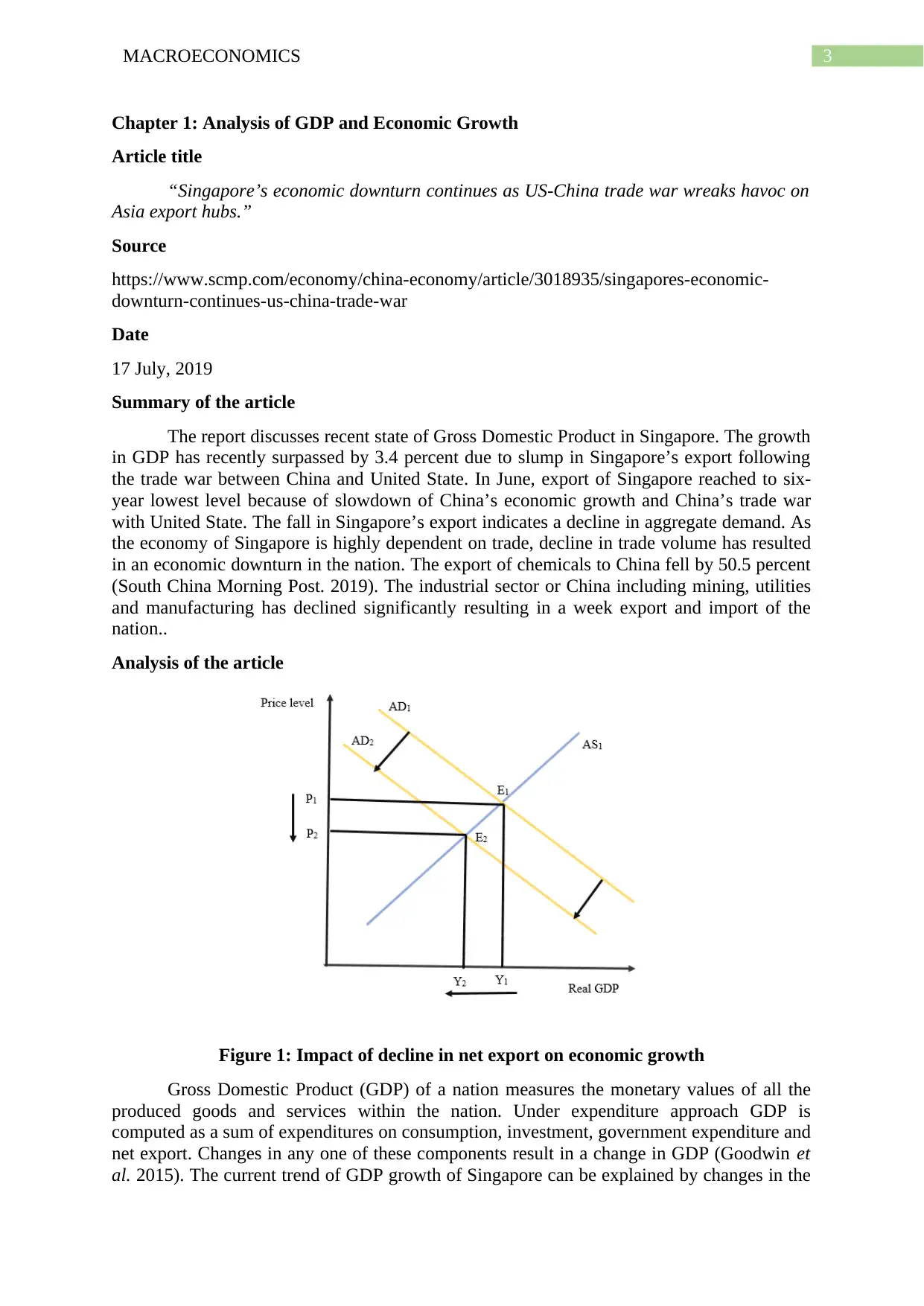
3MACROECONOMICS
Chapter 1: Analysis of GDP and Economic Growth
Article title
“Singapore’s economic downturn continues as US-China trade war wreaks havoc on
Asia export hubs.”
Source
https://www.scmp.com/economy/china-economy/article/3018935/singapores-economic-
downturn-continues-us-china-trade-war
Date
17 July, 2019
Summary of the article
The report discusses recent state of Gross Domestic Product in Singapore. The growth
in GDP has recently surpassed by 3.4 percent due to slump in Singapore’s export following
the trade war between China and United State. In June, export of Singapore reached to six-
year lowest level because of slowdown of China’s economic growth and China’s trade war
with United State. The fall in Singapore’s export indicates a decline in aggregate demand. As
the economy of Singapore is highly dependent on trade, decline in trade volume has resulted
in an economic downturn in the nation. The export of chemicals to China fell by 50.5 percent
(South China Morning Post. 2019). The industrial sector or China including mining, utilities
and manufacturing has declined significantly resulting in a week export and import of the
nation..
Analysis of the article
Figure 1: Impact of decline in net export on economic growth
Gross Domestic Product (GDP) of a nation measures the monetary values of all the
produced goods and services within the nation. Under expenditure approach GDP is
computed as a sum of expenditures on consumption, investment, government expenditure and
net export. Changes in any one of these components result in a change in GDP (Goodwin et
al. 2015). The current trend of GDP growth of Singapore can be explained by changes in the
Chapter 1: Analysis of GDP and Economic Growth
Article title
“Singapore’s economic downturn continues as US-China trade war wreaks havoc on
Asia export hubs.”
Source
https://www.scmp.com/economy/china-economy/article/3018935/singapores-economic-
downturn-continues-us-china-trade-war
Date
17 July, 2019
Summary of the article
The report discusses recent state of Gross Domestic Product in Singapore. The growth
in GDP has recently surpassed by 3.4 percent due to slump in Singapore’s export following
the trade war between China and United State. In June, export of Singapore reached to six-
year lowest level because of slowdown of China’s economic growth and China’s trade war
with United State. The fall in Singapore’s export indicates a decline in aggregate demand. As
the economy of Singapore is highly dependent on trade, decline in trade volume has resulted
in an economic downturn in the nation. The export of chemicals to China fell by 50.5 percent
(South China Morning Post. 2019). The industrial sector or China including mining, utilities
and manufacturing has declined significantly resulting in a week export and import of the
nation..
Analysis of the article
Figure 1: Impact of decline in net export on economic growth
Gross Domestic Product (GDP) of a nation measures the monetary values of all the
produced goods and services within the nation. Under expenditure approach GDP is
computed as a sum of expenditures on consumption, investment, government expenditure and
net export. Changes in any one of these components result in a change in GDP (Goodwin et
al. 2015). The current trend of GDP growth of Singapore can be explained by changes in the
Paraphrase This Document
Need a fresh take? Get an instant paraphrase of this document with our AI Paraphraser
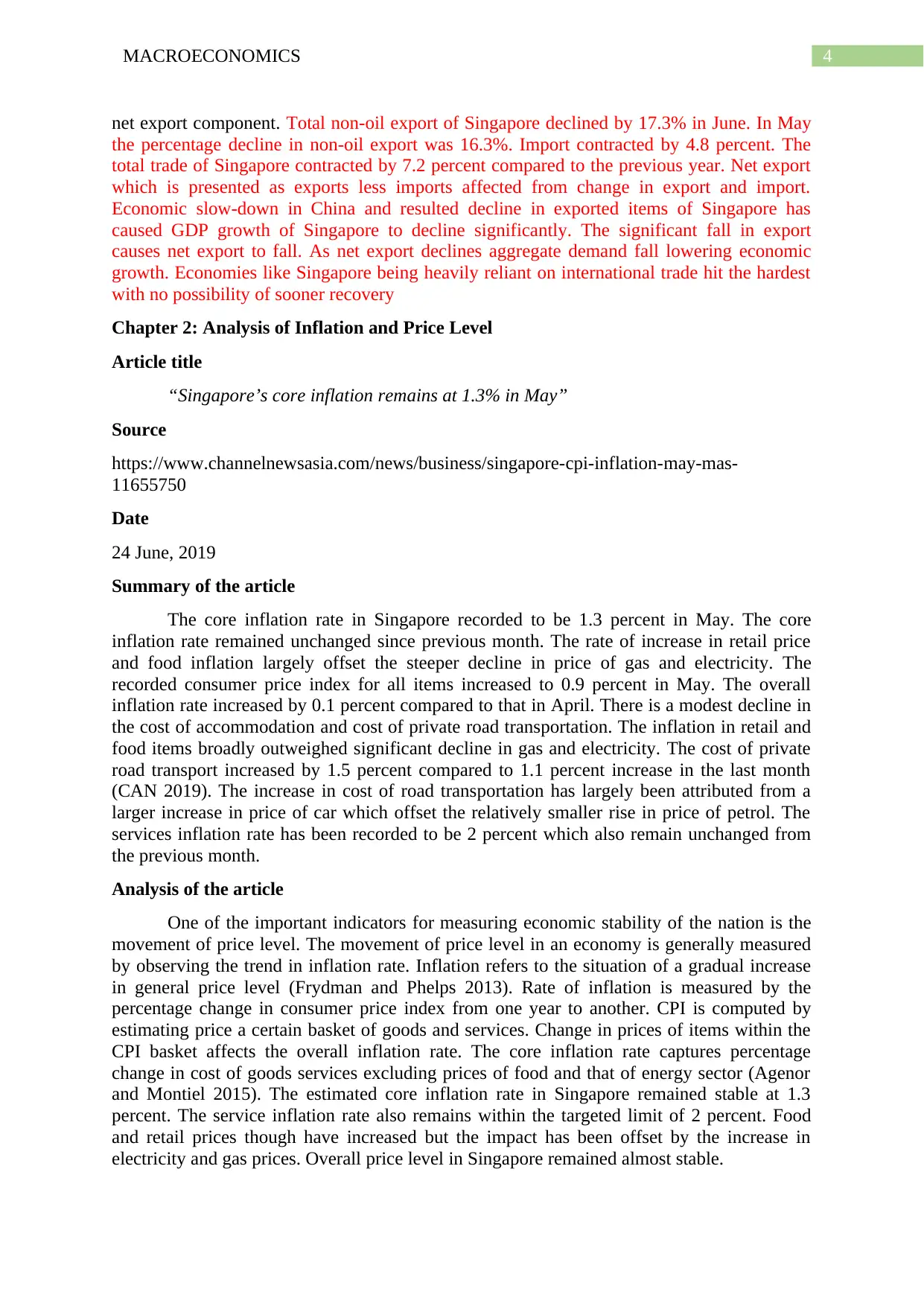
4MACROECONOMICS
net export component. Total non-oil export of Singapore declined by 17.3% in June. In May
the percentage decline in non-oil export was 16.3%. Import contracted by 4.8 percent. The
total trade of Singapore contracted by 7.2 percent compared to the previous year. Net export
which is presented as exports less imports affected from change in export and import.
Economic slow-down in China and resulted decline in exported items of Singapore has
caused GDP growth of Singapore to decline significantly. The significant fall in export
causes net export to fall. As net export declines aggregate demand fall lowering economic
growth. Economies like Singapore being heavily reliant on international trade hit the hardest
with no possibility of sooner recovery
Chapter 2: Analysis of Inflation and Price Level
Article title
“Singapore’s core inflation remains at 1.3% in May”
Source
https://www.channelnewsasia.com/news/business/singapore-cpi-inflation-may-mas-
11655750
Date
24 June, 2019
Summary of the article
The core inflation rate in Singapore recorded to be 1.3 percent in May. The core
inflation rate remained unchanged since previous month. The rate of increase in retail price
and food inflation largely offset the steeper decline in price of gas and electricity. The
recorded consumer price index for all items increased to 0.9 percent in May. The overall
inflation rate increased by 0.1 percent compared to that in April. There is a modest decline in
the cost of accommodation and cost of private road transportation. The inflation in retail and
food items broadly outweighed significant decline in gas and electricity. The cost of private
road transport increased by 1.5 percent compared to 1.1 percent increase in the last month
(CAN 2019). The increase in cost of road transportation has largely been attributed from a
larger increase in price of car which offset the relatively smaller rise in price of petrol. The
services inflation rate has been recorded to be 2 percent which also remain unchanged from
the previous month.
Analysis of the article
One of the important indicators for measuring economic stability of the nation is the
movement of price level. The movement of price level in an economy is generally measured
by observing the trend in inflation rate. Inflation refers to the situation of a gradual increase
in general price level (Frydman and Phelps 2013). Rate of inflation is measured by the
percentage change in consumer price index from one year to another. CPI is computed by
estimating price a certain basket of goods and services. Change in prices of items within the
CPI basket affects the overall inflation rate. The core inflation rate captures percentage
change in cost of goods services excluding prices of food and that of energy sector (Agenor
and Montiel 2015). The estimated core inflation rate in Singapore remained stable at 1.3
percent. The service inflation rate also remains within the targeted limit of 2 percent. Food
and retail prices though have increased but the impact has been offset by the increase in
electricity and gas prices. Overall price level in Singapore remained almost stable.
net export component. Total non-oil export of Singapore declined by 17.3% in June. In May
the percentage decline in non-oil export was 16.3%. Import contracted by 4.8 percent. The
total trade of Singapore contracted by 7.2 percent compared to the previous year. Net export
which is presented as exports less imports affected from change in export and import.
Economic slow-down in China and resulted decline in exported items of Singapore has
caused GDP growth of Singapore to decline significantly. The significant fall in export
causes net export to fall. As net export declines aggregate demand fall lowering economic
growth. Economies like Singapore being heavily reliant on international trade hit the hardest
with no possibility of sooner recovery
Chapter 2: Analysis of Inflation and Price Level
Article title
“Singapore’s core inflation remains at 1.3% in May”
Source
https://www.channelnewsasia.com/news/business/singapore-cpi-inflation-may-mas-
11655750
Date
24 June, 2019
Summary of the article
The core inflation rate in Singapore recorded to be 1.3 percent in May. The core
inflation rate remained unchanged since previous month. The rate of increase in retail price
and food inflation largely offset the steeper decline in price of gas and electricity. The
recorded consumer price index for all items increased to 0.9 percent in May. The overall
inflation rate increased by 0.1 percent compared to that in April. There is a modest decline in
the cost of accommodation and cost of private road transportation. The inflation in retail and
food items broadly outweighed significant decline in gas and electricity. The cost of private
road transport increased by 1.5 percent compared to 1.1 percent increase in the last month
(CAN 2019). The increase in cost of road transportation has largely been attributed from a
larger increase in price of car which offset the relatively smaller rise in price of petrol. The
services inflation rate has been recorded to be 2 percent which also remain unchanged from
the previous month.
Analysis of the article
One of the important indicators for measuring economic stability of the nation is the
movement of price level. The movement of price level in an economy is generally measured
by observing the trend in inflation rate. Inflation refers to the situation of a gradual increase
in general price level (Frydman and Phelps 2013). Rate of inflation is measured by the
percentage change in consumer price index from one year to another. CPI is computed by
estimating price a certain basket of goods and services. Change in prices of items within the
CPI basket affects the overall inflation rate. The core inflation rate captures percentage
change in cost of goods services excluding prices of food and that of energy sector (Agenor
and Montiel 2015). The estimated core inflation rate in Singapore remained stable at 1.3
percent. The service inflation rate also remains within the targeted limit of 2 percent. Food
and retail prices though have increased but the impact has been offset by the increase in
electricity and gas prices. Overall price level in Singapore remained almost stable.
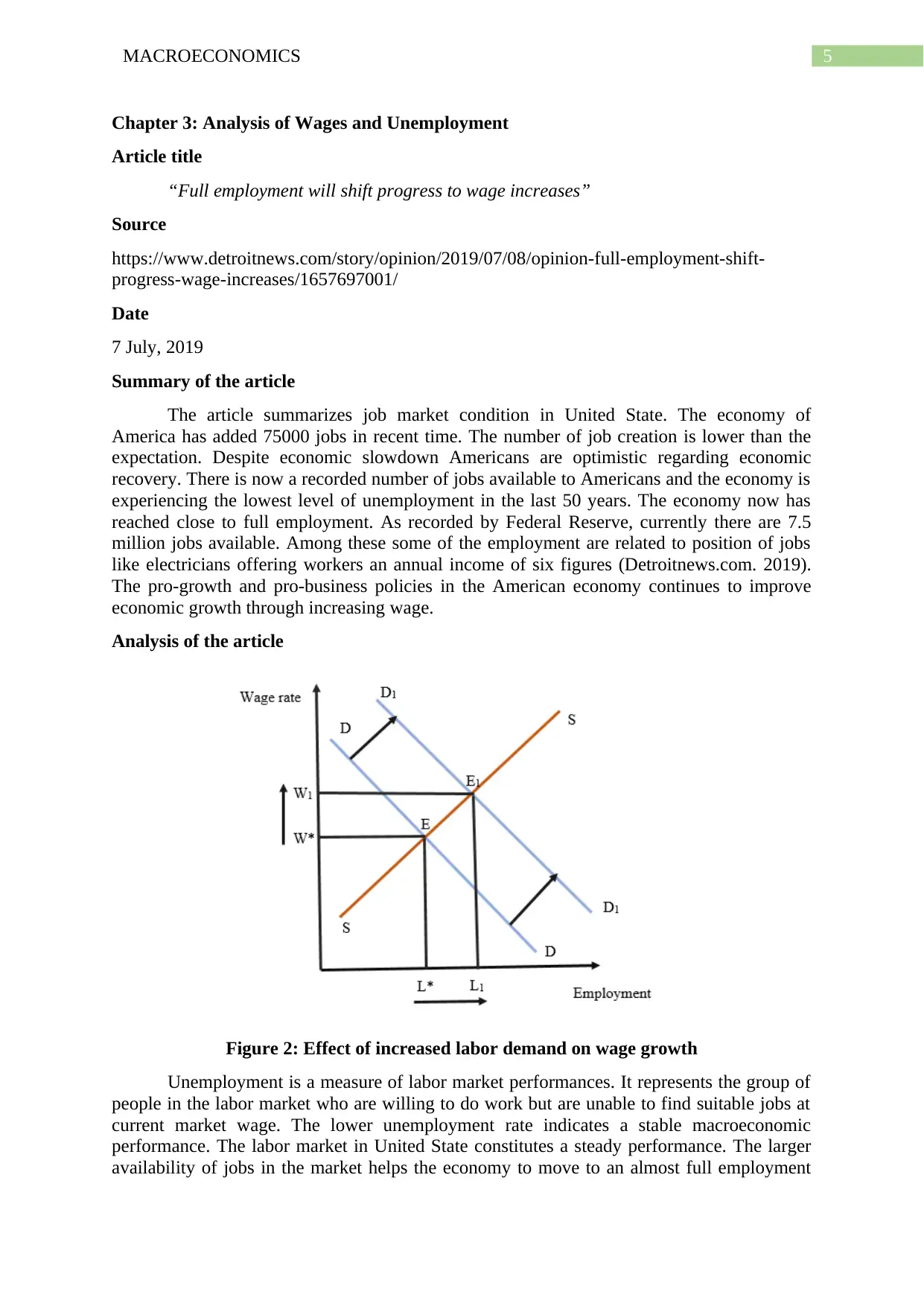
5MACROECONOMICS
Chapter 3: Analysis of Wages and Unemployment
Article title
“Full employment will shift progress to wage increases”
Source
https://www.detroitnews.com/story/opinion/2019/07/08/opinion-full-employment-shift-
progress-wage-increases/1657697001/
Date
7 July, 2019
Summary of the article
The article summarizes job market condition in United State. The economy of
America has added 75000 jobs in recent time. The number of job creation is lower than the
expectation. Despite economic slowdown Americans are optimistic regarding economic
recovery. There is now a recorded number of jobs available to Americans and the economy is
experiencing the lowest level of unemployment in the last 50 years. The economy now has
reached close to full employment. As recorded by Federal Reserve, currently there are 7.5
million jobs available. Among these some of the employment are related to position of jobs
like electricians offering workers an annual income of six figures (Detroitnews.com. 2019).
The pro-growth and pro-business policies in the American economy continues to improve
economic growth through increasing wage.
Analysis of the article
Figure 2: Effect of increased labor demand on wage growth
Unemployment is a measure of labor market performances. It represents the group of
people in the labor market who are willing to do work but are unable to find suitable jobs at
current market wage. The lower unemployment rate indicates a stable macroeconomic
performance. The labor market in United State constitutes a steady performance. The larger
availability of jobs in the market helps the economy to move to an almost full employment
Chapter 3: Analysis of Wages and Unemployment
Article title
“Full employment will shift progress to wage increases”
Source
https://www.detroitnews.com/story/opinion/2019/07/08/opinion-full-employment-shift-
progress-wage-increases/1657697001/
Date
7 July, 2019
Summary of the article
The article summarizes job market condition in United State. The economy of
America has added 75000 jobs in recent time. The number of job creation is lower than the
expectation. Despite economic slowdown Americans are optimistic regarding economic
recovery. There is now a recorded number of jobs available to Americans and the economy is
experiencing the lowest level of unemployment in the last 50 years. The economy now has
reached close to full employment. As recorded by Federal Reserve, currently there are 7.5
million jobs available. Among these some of the employment are related to position of jobs
like electricians offering workers an annual income of six figures (Detroitnews.com. 2019).
The pro-growth and pro-business policies in the American economy continues to improve
economic growth through increasing wage.
Analysis of the article
Figure 2: Effect of increased labor demand on wage growth
Unemployment is a measure of labor market performances. It represents the group of
people in the labor market who are willing to do work but are unable to find suitable jobs at
current market wage. The lower unemployment rate indicates a stable macroeconomic
performance. The labor market in United State constitutes a steady performance. The larger
availability of jobs in the market helps the economy to move to an almost full employment
⊘ This is a preview!⊘
Do you want full access?
Subscribe today to unlock all pages.

Trusted by 1+ million students worldwide

6MACROECONOMICS
situation. The full employment indicates a situation where everybody looking for a job gets a
job (Uribe and Schmitt-Grohe 2017). The skill shortage in the economy can result in a slower
economic growth. As the number of available jobs exceeds the number of unemployed people
the employers can bargain wages. The companies are started to increase wage with an effort
to become more competitive. Increase in demand for skilled labors shifts the labor demand
curve rightward as shown in figure 2. Equilibrium in the labor market shifts from E to E1
increasing wage from W* to W1. With an increase in wage rate economic growth increases.
US economy thus has constituted steady performances in terms of economic output and
employment.
Chapter 4: Analysis of Saving, Capital Formation, Financial Markets and Financial
System
Article title
“Regulatory, capital market reforms needed to revive Singapore’s stock market.”
Source
https://medium.com/venture-views/regulatory-capital-market-reforms-needed-to-revive-
singapores-stock-market-3e9e497e3338
Date
11 July, 2019
Summary of the article
The article discusses capital market reform in Singapore. The discussion also includes
pension system and interaction of regulators to the public equity market. Lack of reforms in
the capital market of Singapore restricts ability of the nation to compete with regional and
international peers. This was eroding status of the economy as a financial center and
continuous liquidity in the market. Capital market in Singapore has established robust
franchise in the capital market derivatives (Medium 2019). The reform also includes
establishments of business trusts, real estate investment trusts and wealth management hubby
employing international best practice.
Analysis of the article
Financial market refers to the marketplace where securities are traded along with
trading of bonds, equities and currencies and derivatives. Capital markets are venues where
investment and saving are channeled between those who need capital and who have capital.
In a nation, capital market plays a vital role in resource mobilization and use them in
productive way (Farre-Mensa and Ljungqvist 2016). Capital market which is an important
part of financial market indicates stability and state of financial market of an economy. The
capital market in Singapore lags behind the international standard and needs some reform.
Particular reforms are needed to improve the capital market, interaction between public and
regulators and the pension system. Since the penny stock crash in 2013, the equity market of
Singapore had been plagued by the mass privatization deals and lack of liquidity. In the
current reform, particular focus has been given on the pension system due to its important
role to support liquidity of domestic investors. The reforms that has been undertaken in the
capital market of Singapore will improve the state of capital market contributing positively to
the economic performances. The stock market of Singapore can support a robust growth of
equity market.
situation. The full employment indicates a situation where everybody looking for a job gets a
job (Uribe and Schmitt-Grohe 2017). The skill shortage in the economy can result in a slower
economic growth. As the number of available jobs exceeds the number of unemployed people
the employers can bargain wages. The companies are started to increase wage with an effort
to become more competitive. Increase in demand for skilled labors shifts the labor demand
curve rightward as shown in figure 2. Equilibrium in the labor market shifts from E to E1
increasing wage from W* to W1. With an increase in wage rate economic growth increases.
US economy thus has constituted steady performances in terms of economic output and
employment.
Chapter 4: Analysis of Saving, Capital Formation, Financial Markets and Financial
System
Article title
“Regulatory, capital market reforms needed to revive Singapore’s stock market.”
Source
https://medium.com/venture-views/regulatory-capital-market-reforms-needed-to-revive-
singapores-stock-market-3e9e497e3338
Date
11 July, 2019
Summary of the article
The article discusses capital market reform in Singapore. The discussion also includes
pension system and interaction of regulators to the public equity market. Lack of reforms in
the capital market of Singapore restricts ability of the nation to compete with regional and
international peers. This was eroding status of the economy as a financial center and
continuous liquidity in the market. Capital market in Singapore has established robust
franchise in the capital market derivatives (Medium 2019). The reform also includes
establishments of business trusts, real estate investment trusts and wealth management hubby
employing international best practice.
Analysis of the article
Financial market refers to the marketplace where securities are traded along with
trading of bonds, equities and currencies and derivatives. Capital markets are venues where
investment and saving are channeled between those who need capital and who have capital.
In a nation, capital market plays a vital role in resource mobilization and use them in
productive way (Farre-Mensa and Ljungqvist 2016). Capital market which is an important
part of financial market indicates stability and state of financial market of an economy. The
capital market in Singapore lags behind the international standard and needs some reform.
Particular reforms are needed to improve the capital market, interaction between public and
regulators and the pension system. Since the penny stock crash in 2013, the equity market of
Singapore had been plagued by the mass privatization deals and lack of liquidity. In the
current reform, particular focus has been given on the pension system due to its important
role to support liquidity of domestic investors. The reforms that has been undertaken in the
capital market of Singapore will improve the state of capital market contributing positively to
the economic performances. The stock market of Singapore can support a robust growth of
equity market.
Paraphrase This Document
Need a fresh take? Get an instant paraphrase of this document with our AI Paraphraser
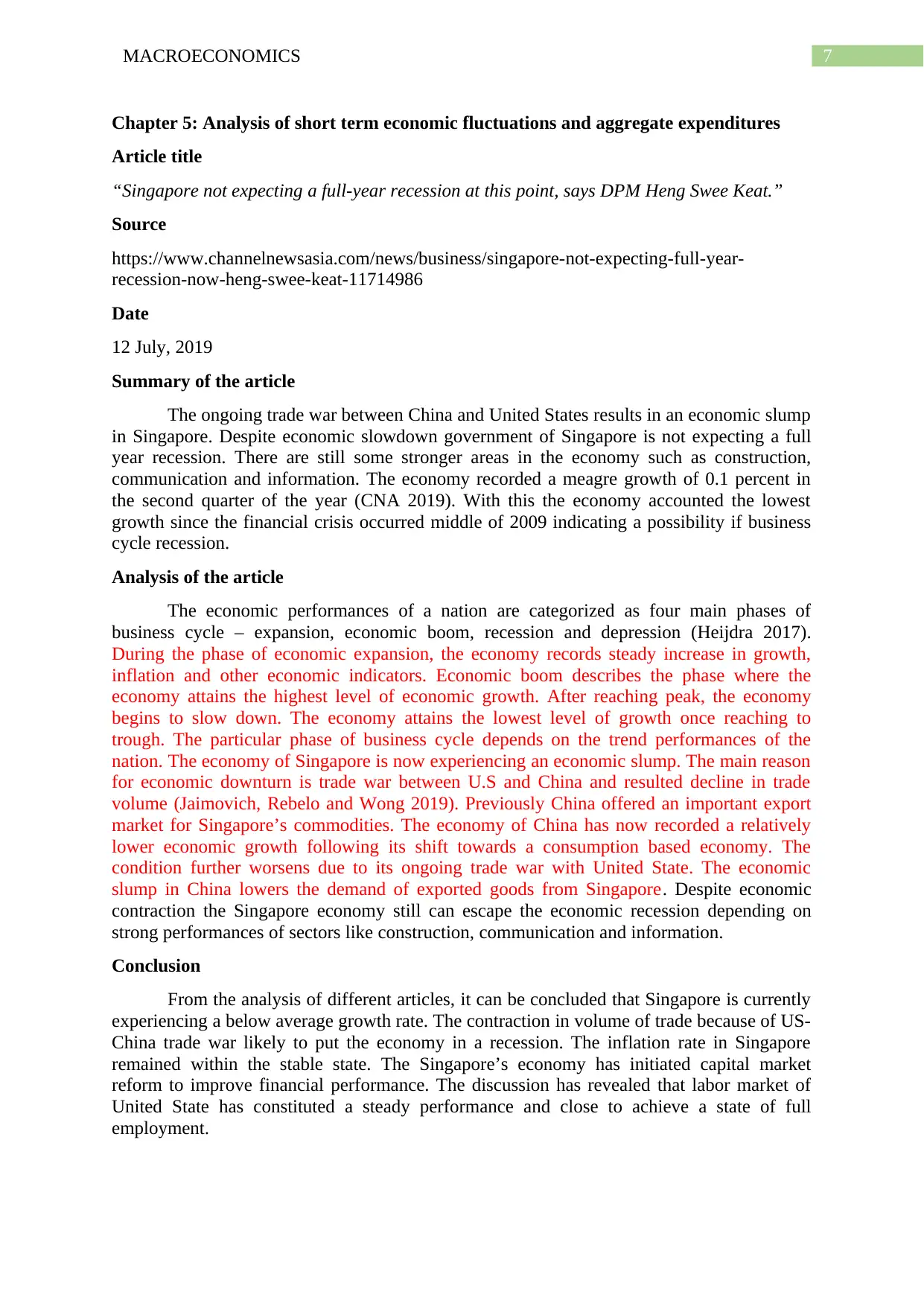
7MACROECONOMICS
Chapter 5: Analysis of short term economic fluctuations and aggregate expenditures
Article title
“Singapore not expecting a full-year recession at this point, says DPM Heng Swee Keat.”
Source
https://www.channelnewsasia.com/news/business/singapore-not-expecting-full-year-
recession-now-heng-swee-keat-11714986
Date
12 July, 2019
Summary of the article
The ongoing trade war between China and United States results in an economic slump
in Singapore. Despite economic slowdown government of Singapore is not expecting a full
year recession. There are still some stronger areas in the economy such as construction,
communication and information. The economy recorded a meagre growth of 0.1 percent in
the second quarter of the year (CNA 2019). With this the economy accounted the lowest
growth since the financial crisis occurred middle of 2009 indicating a possibility if business
cycle recession.
Analysis of the article
The economic performances of a nation are categorized as four main phases of
business cycle – expansion, economic boom, recession and depression (Heijdra 2017).
During the phase of economic expansion, the economy records steady increase in growth,
inflation and other economic indicators. Economic boom describes the phase where the
economy attains the highest level of economic growth. After reaching peak, the economy
begins to slow down. The economy attains the lowest level of growth once reaching to
trough. The particular phase of business cycle depends on the trend performances of the
nation. The economy of Singapore is now experiencing an economic slump. The main reason
for economic downturn is trade war between U.S and China and resulted decline in trade
volume (Jaimovich, Rebelo and Wong 2019). Previously China offered an important export
market for Singapore’s commodities. The economy of China has now recorded a relatively
lower economic growth following its shift towards a consumption based economy. The
condition further worsens due to its ongoing trade war with United State. The economic
slump in China lowers the demand of exported goods from Singapore. Despite economic
contraction the Singapore economy still can escape the economic recession depending on
strong performances of sectors like construction, communication and information.
Conclusion
From the analysis of different articles, it can be concluded that Singapore is currently
experiencing a below average growth rate. The contraction in volume of trade because of US-
China trade war likely to put the economy in a recession. The inflation rate in Singapore
remained within the stable state. The Singapore’s economy has initiated capital market
reform to improve financial performance. The discussion has revealed that labor market of
United State has constituted a steady performance and close to achieve a state of full
employment.
Chapter 5: Analysis of short term economic fluctuations and aggregate expenditures
Article title
“Singapore not expecting a full-year recession at this point, says DPM Heng Swee Keat.”
Source
https://www.channelnewsasia.com/news/business/singapore-not-expecting-full-year-
recession-now-heng-swee-keat-11714986
Date
12 July, 2019
Summary of the article
The ongoing trade war between China and United States results in an economic slump
in Singapore. Despite economic slowdown government of Singapore is not expecting a full
year recession. There are still some stronger areas in the economy such as construction,
communication and information. The economy recorded a meagre growth of 0.1 percent in
the second quarter of the year (CNA 2019). With this the economy accounted the lowest
growth since the financial crisis occurred middle of 2009 indicating a possibility if business
cycle recession.
Analysis of the article
The economic performances of a nation are categorized as four main phases of
business cycle – expansion, economic boom, recession and depression (Heijdra 2017).
During the phase of economic expansion, the economy records steady increase in growth,
inflation and other economic indicators. Economic boom describes the phase where the
economy attains the highest level of economic growth. After reaching peak, the economy
begins to slow down. The economy attains the lowest level of growth once reaching to
trough. The particular phase of business cycle depends on the trend performances of the
nation. The economy of Singapore is now experiencing an economic slump. The main reason
for economic downturn is trade war between U.S and China and resulted decline in trade
volume (Jaimovich, Rebelo and Wong 2019). Previously China offered an important export
market for Singapore’s commodities. The economy of China has now recorded a relatively
lower economic growth following its shift towards a consumption based economy. The
condition further worsens due to its ongoing trade war with United State. The economic
slump in China lowers the demand of exported goods from Singapore. Despite economic
contraction the Singapore economy still can escape the economic recession depending on
strong performances of sectors like construction, communication and information.
Conclusion
From the analysis of different articles, it can be concluded that Singapore is currently
experiencing a below average growth rate. The contraction in volume of trade because of US-
China trade war likely to put the economy in a recession. The inflation rate in Singapore
remained within the stable state. The Singapore’s economy has initiated capital market
reform to improve financial performance. The discussion has revealed that labor market of
United State has constituted a steady performance and close to achieve a state of full
employment.
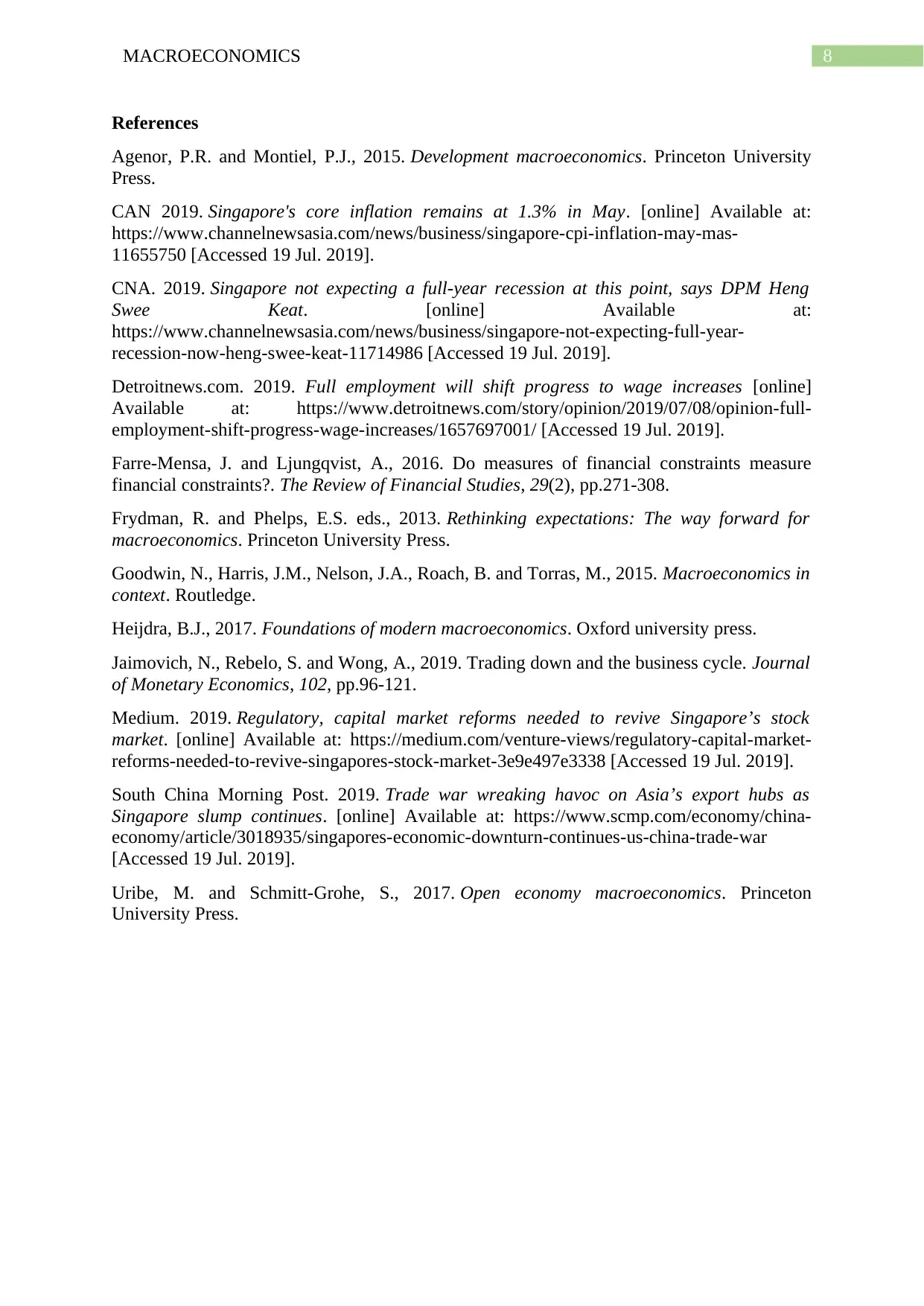
8MACROECONOMICS
References
Agenor, P.R. and Montiel, P.J., 2015. Development macroeconomics. Princeton University
Press.
CAN 2019. Singapore's core inflation remains at 1.3% in May. [online] Available at:
https://www.channelnewsasia.com/news/business/singapore-cpi-inflation-may-mas-
11655750 [Accessed 19 Jul. 2019].
CNA. 2019. Singapore not expecting a full-year recession at this point, says DPM Heng
Swee Keat. [online] Available at:
https://www.channelnewsasia.com/news/business/singapore-not-expecting-full-year-
recession-now-heng-swee-keat-11714986 [Accessed 19 Jul. 2019].
Detroitnews.com. 2019. Full employment will shift progress to wage increases [online]
Available at: https://www.detroitnews.com/story/opinion/2019/07/08/opinion-full-
employment-shift-progress-wage-increases/1657697001/ [Accessed 19 Jul. 2019].
Farre-Mensa, J. and Ljungqvist, A., 2016. Do measures of financial constraints measure
financial constraints?. The Review of Financial Studies, 29(2), pp.271-308.
Frydman, R. and Phelps, E.S. eds., 2013. Rethinking expectations: The way forward for
macroeconomics. Princeton University Press.
Goodwin, N., Harris, J.M., Nelson, J.A., Roach, B. and Torras, M., 2015. Macroeconomics in
context. Routledge.
Heijdra, B.J., 2017. Foundations of modern macroeconomics. Oxford university press.
Jaimovich, N., Rebelo, S. and Wong, A., 2019. Trading down and the business cycle. Journal
of Monetary Economics, 102, pp.96-121.
Medium. 2019. Regulatory, capital market reforms needed to revive Singapore’s stock
market. [online] Available at: https://medium.com/venture-views/regulatory-capital-market-
reforms-needed-to-revive-singapores-stock-market-3e9e497e3338 [Accessed 19 Jul. 2019].
South China Morning Post. 2019. Trade war wreaking havoc on Asia’s export hubs as
Singapore slump continues. [online] Available at: https://www.scmp.com/economy/china-
economy/article/3018935/singapores-economic-downturn-continues-us-china-trade-war
[Accessed 19 Jul. 2019].
Uribe, M. and Schmitt-Grohe, S., 2017. Open economy macroeconomics. Princeton
University Press.
References
Agenor, P.R. and Montiel, P.J., 2015. Development macroeconomics. Princeton University
Press.
CAN 2019. Singapore's core inflation remains at 1.3% in May. [online] Available at:
https://www.channelnewsasia.com/news/business/singapore-cpi-inflation-may-mas-
11655750 [Accessed 19 Jul. 2019].
CNA. 2019. Singapore not expecting a full-year recession at this point, says DPM Heng
Swee Keat. [online] Available at:
https://www.channelnewsasia.com/news/business/singapore-not-expecting-full-year-
recession-now-heng-swee-keat-11714986 [Accessed 19 Jul. 2019].
Detroitnews.com. 2019. Full employment will shift progress to wage increases [online]
Available at: https://www.detroitnews.com/story/opinion/2019/07/08/opinion-full-
employment-shift-progress-wage-increases/1657697001/ [Accessed 19 Jul. 2019].
Farre-Mensa, J. and Ljungqvist, A., 2016. Do measures of financial constraints measure
financial constraints?. The Review of Financial Studies, 29(2), pp.271-308.
Frydman, R. and Phelps, E.S. eds., 2013. Rethinking expectations: The way forward for
macroeconomics. Princeton University Press.
Goodwin, N., Harris, J.M., Nelson, J.A., Roach, B. and Torras, M., 2015. Macroeconomics in
context. Routledge.
Heijdra, B.J., 2017. Foundations of modern macroeconomics. Oxford university press.
Jaimovich, N., Rebelo, S. and Wong, A., 2019. Trading down and the business cycle. Journal
of Monetary Economics, 102, pp.96-121.
Medium. 2019. Regulatory, capital market reforms needed to revive Singapore’s stock
market. [online] Available at: https://medium.com/venture-views/regulatory-capital-market-
reforms-needed-to-revive-singapores-stock-market-3e9e497e3338 [Accessed 19 Jul. 2019].
South China Morning Post. 2019. Trade war wreaking havoc on Asia’s export hubs as
Singapore slump continues. [online] Available at: https://www.scmp.com/economy/china-
economy/article/3018935/singapores-economic-downturn-continues-us-china-trade-war
[Accessed 19 Jul. 2019].
Uribe, M. and Schmitt-Grohe, S., 2017. Open economy macroeconomics. Princeton
University Press.
⊘ This is a preview!⊘
Do you want full access?
Subscribe today to unlock all pages.

Trusted by 1+ million students worldwide
1 out of 9
Related Documents
Your All-in-One AI-Powered Toolkit for Academic Success.
+13062052269
info@desklib.com
Available 24*7 on WhatsApp / Email
![[object Object]](/_next/static/media/star-bottom.7253800d.svg)
Unlock your academic potential
Copyright © 2020–2025 A2Z Services. All Rights Reserved. Developed and managed by ZUCOL.



